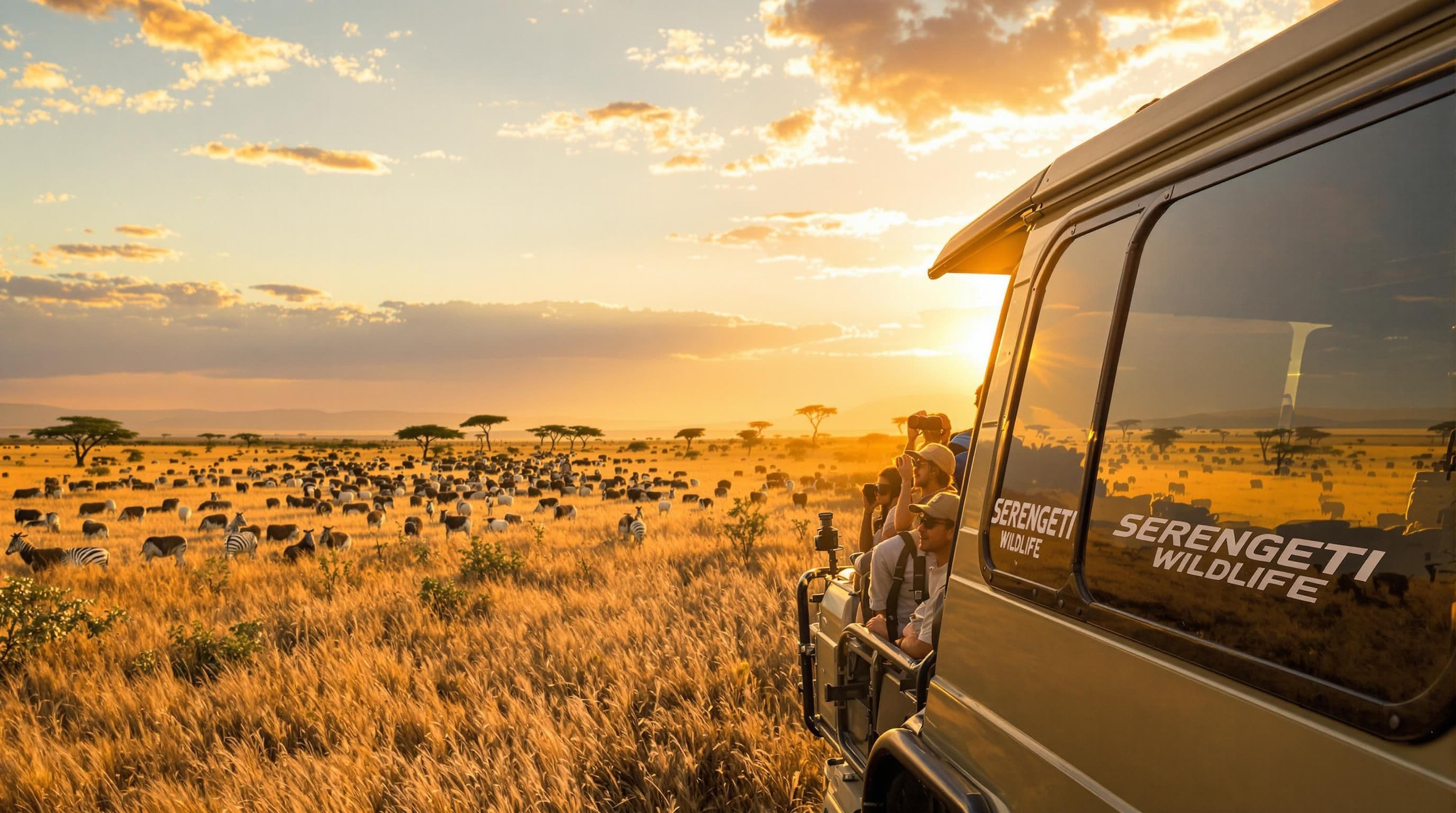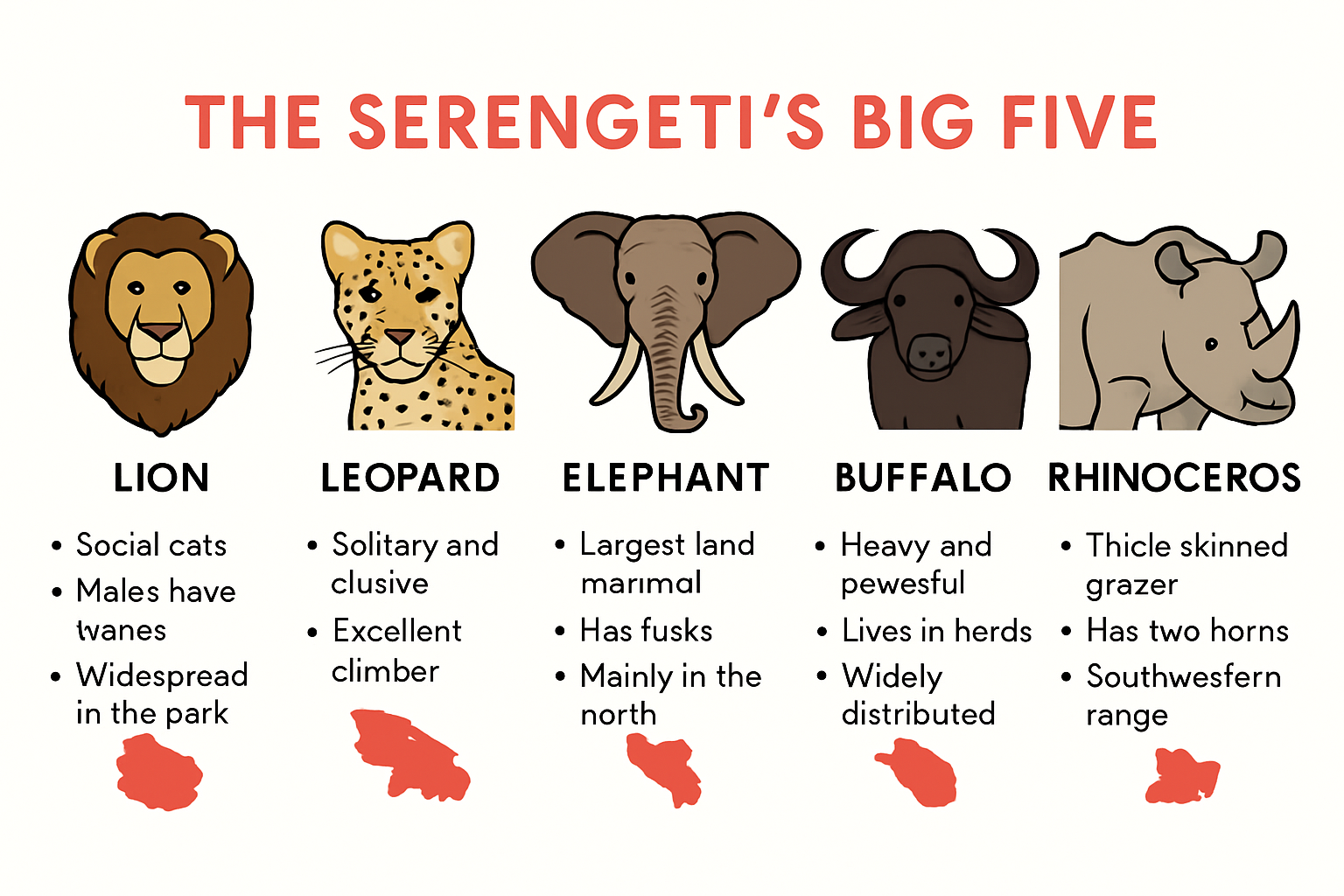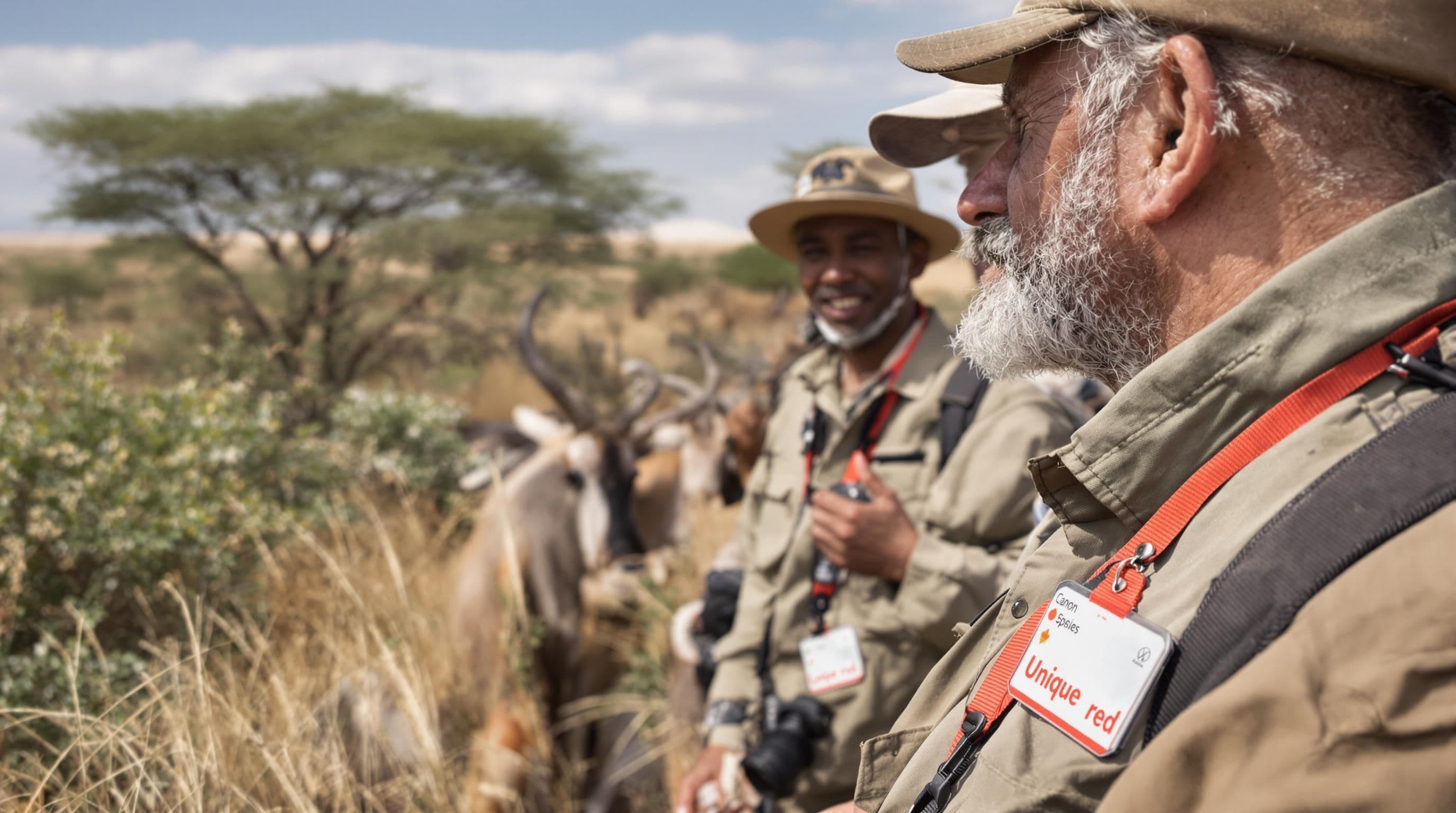What Animals Live in Serengeti: A Guide for Safari Travelers 2025
Full Disclosure: Our AI Assistant Writes These!
While we're out in the bush tracking leopards, dodging elephants, and trying to get the perfect sunset shot, our trusty AI companion is back at camp, diligently crafting these blog posts. Don't worry though - it's been trained on years of real safari experiences and only occasionally suggests that tourists should pet the lions. (Please don't pet the lions. The AI was joking. We hope.)
The real reason? SEO loves fresh content, and we love fresh adventures. So while our AI handles the keywords and search rankings, we're out there finding the next hidden waterhole, secret viewpoint, or that one tree where the leopards always hang out. Win-win, really!
What Animals Live in Serengeti: A Guide for Safari Travelers 2025

The Serengeti is famous for its wild beauty and legendary animals like lions, elephants and leopards. Every year more than two million wildebeest thunder across the plains in the world’s biggest animal migration. Most people think it is just the place to spot the Big Five, but there are secret wonders everywhere if you know where to look. Hidden in between those well-known giants, the Serengeti shelters rare creatures, over 500 types of birds and tiny species you will not find anywhere else on earth.
Table of Contents
- Serengeti’s Famous Big Five Wildlife
- Unique Animals Only Found In Serengeti
- Birdlife And Lesser-Known Species To Spot
- When And Where To See Wildlife Best
Quick Summary
| Takeaway | Explanation |
|---|---|
| Witness the Big Five in Serengeti | See lions, leopards, elephants, buffalo, and rhinoceros, which are the iconic wildlife of the region. |
| Optimal Viewing Seasons | Best wildlife sightings occur during specific times, such as December to March for calving or June to July for dramatic river crossings. |
| Endemic Species to Explore | Unique species like the western white-bearded wildebeest and fringe-eared oryx are integral to the Serengeti’s biodiversity. |
| Respect Wildlife Viewing Practices | Approach wildlife with consideration, maintaining safe distances to ensure ecological balance and animal welfare. |
| Diverse Birdwatching Opportunities | The Serengeti hosts over 500 bird species, providing exceptional opportunities for birdwatchers and wildlife photographers. |
Serengeti’s Famous Big Five Wildlife

The Serengeti ecosystem represents a pinnacle of wildlife diversity, with its most iconic residents being the legendary Big Five - lions, leopards, elephants, buffalo, and rhinoceros. These magnificent creatures have captured the imagination of safari travelers for generations, symbolizing the raw power and beauty of African wilderness.
The Predators: Lions and Leopards
Lions dominate the Serengeti landscape, forming complex social structures within their prides. According to research from the Serengeti Lion Project, these apex predators maintain intricate territorial dynamics that have fascinated wildlife researchers for decades. Male lions, with their distinctive manes, command territories spanning vast grasslands, while females do most of the hunting for their pride. Their strategic hunting techniques and social behaviors make them one of the most compelling wildlife experiences in the region.
Leopards, by contrast, represent stealth and solitary elegance. These elusive cats are masters of camouflage, often spotted draped across tree branches or hidden in dense vegetation. Their hunting strategies rely on surprise and incredible strength, allowing them to take down prey much larger than themselves. Wildlife conservation studies indicate that leopard populations remain relatively stable in the Serengeti, though they face challenges from habitat fragmentation and human-wildlife conflicts.
Herbivore Giants: Elephants and Buffalo
African elephants in the Serengeti are truly remarkable creatures. These massive mammals travel in herds led by experienced matriarchs, displaying complex social intelligence and emotional depth. Their migratory patterns play a crucial role in shaping the ecosystem, creating pathways that benefit numerous other species. Buffalo herds represent another powerful presence in the landscape, moving in large numbers and demonstrating remarkable resilience. Their collective defense mechanisms against predators showcase extraordinary group survival strategies.
These herbivores are not just passive inhabitants but active architects of the Serengeti’s ecological balance. Their grazing patterns, movement, and interactions create intricate networks that support the entire ecosystem’s biodiversity.
Conservation and Challenges
While the Big Five remain iconic symbols of African wildlife, they face significant conservation challenges. Habitat loss, poaching, and human-wildlife conflicts continue to threaten their populations. The black rhinoceros, in particular, has experienced dramatic population declines, making sightings increasingly rare in the Serengeti.
Conservation efforts have become critical in protecting these magnificent animals. Research and protective strategies aim to maintain ecological balance while ensuring the survival of these incredible species for future generations of wildlife enthusiasts and researchers.
Travelers visiting the Serengeti should approach wildlife viewing with respect, understanding that these are not mere tourist attractions but complex beings with sophisticated social structures and critical roles in maintaining environmental equilibrium.
Unique Animals Only Found in Serengeti

The Serengeti ecosystem hosts an extraordinary array of wildlife species that represent remarkable evolutionary adaptations and ecological specialization. While many animals inhabit multiple regions across Africa, some creatures are uniquely adapted to this spectacular landscape, making wildlife encounters here truly exceptional.
Endemic Mammals of the Serengeti
The western white-bearded wildebeest stands as a quintessential example of a species intrinsically linked to the Serengeti. Scientific research from the African Wildlife Foundation reveals that this subspecies comprises over one million individuals who execute one of nature’s most dramatic annual migrations. These remarkable animals traverse hundreds of kilometers between Tanzania and Kenya, creating a spectacle that defines the region’s ecological rhythm.
Another fascinating resident is the fringe-eared oryx, a subspecies with a remarkably restricted geographical range. According to wildlife conservation studies, these antelopes have gradually expanded their territory, with herds first moving into the Serengeti National Park in 1972. Their ability to survive in arid conditions makes them a testament to the ecosystem’s biodiversity.
Reptilian and Smaller Inhabitants
Beyond mammals, the Serengeti hosts unique reptilian species that often escape casual observation. The Kenyan rock agama (Agama lionotus) represents a fascinating example of localized wildlife. Herpetological research indicates that this lizard species displays extraordinary color variations and behavioral adaptations specifically suited to the Serengeti’s rocky terrain. Males exhibit vibrant coloration during mating seasons, creating stunning visual displays against the landscape’s earthy tones.
Smaller creatures like the Fischer’s lovebird, a tiny parrot species endemic to northern Tanzania, add another layer of uniqueness to the Serengeti’s biodiversity. These small, brightly colored birds form tight-knit social groups and represent another example of the region’s specialized wildlife.
Conservation and Ecological Significance
The presence of these unique species underscores the Serengeti’s critical role in global biodiversity conservation. Each organism, from the massive wildebeest herds to the tiny rock agama, plays a crucial part in maintaining the ecosystem’s delicate balance. Their specialized adaptations reflect millions of years of evolutionary processes specifically tailored to this extraordinary landscape.
Travelers venturing into the Serengeti should approach wildlife viewing with reverence, understanding that they are witnessing living ecosystems where each species represents a complex narrative of survival, adaptation, and interconnectedness. The unique animals found here are not merely inhabitants but living repositories of evolutionary history, offering profound insights into nature’s remarkable diversity.
Below is a table summarising some of the unique and endemic species mentioned in this section, along with their notable features and ecological roles:
| Species | Endemic To Serengeti/Northern Tanzania | Notable Adaptation or Role |
|---|---|---|
| Western White-Bearded Wildebeest | Serengeti Ecosystem | Drives world’s largest migration, supports predators |
| Fringe-Eared Oryx | Serengeti & select regions | Survives arid zones, expanding its territory |
| Kenyan Rock Agama | Serengeti rocky habitats | Dramatic color changes during mating |
| Fischer’s Lovebird | Northern Tanzania | Endemic, social, forms tight groups |
Birdlife and Lesser-Known Species To Spot
The Serengeti represents a birdwatcher’s paradise, hosting an extraordinary diversity of avian species that transform the landscape into a vibrant canvas of movement and sound. Official wildlife surveys reveal over 500 bird species calling this ecosystem home, offering travelers an unparalleled opportunity to explore beyond the iconic large mammals.
Spectacular Avian Diversity
Ostriches dominate the grassland horizons, their impressive stature making them impossible to miss. These massive flightless birds can reach heights of up to 2.7 meters, representing the largest bird species on the African continent. Ornithological research from the African Bird Atlas indicates that Serengeti ostriches play crucial roles in seed dispersal and grassland ecosystem maintenance.
The kori bustard emerges as another remarkable resident, holding the distinction of being the heaviest flying bird in the world. Males can weigh up to 18 kilograms, performing elaborate courtship displays that showcase intricate feather movements and complex behavioral patterns. Their presence symbolizes the remarkable adaptability of Serengeti wildlife, demonstrating how creatures survive and thrive in challenging environmental conditions.
Rare and Endemic Bird Species
Fischer’s lovebird represents a true gem among Serengeti’s avian inhabitants. These small, brilliantly colored parrots are endemic to northern Tanzania, displaying vibrant green and orange plumage that makes them stand out against the golden grasslands. Their complex social structures and tight-knit flocking behaviors offer fascinating insights into avian community dynamics.
Lesser-known species like the secretary bird present unique hunting strategies that captivate wildlife enthusiasts. These remarkable predatory birds stride across grasslands, using their long legs to stomp and flush out small prey like insects and reptiles. Their distinctive appearance - featuring elongated legs and a raptor-like head - makes them one of the most distinctive birds in the Serengeti ecosystem.
Seasonal Migrations and Ecological Significance
Migratory bird species transform the Serengeti’s avian landscape throughout the year. Numerous European and Asian bird species use this ecosystem as a critical wintering ground, creating complex ecological networks that extend far beyond local boundaries. Species like the white stork and European roller undertake incredible journeys, traveling thousands of kilometers to feed and recuperate in the Serengeti’s rich habitats.
These birds are not merely passive inhabitants but active participants in complex ecological interactions. They contribute to seed dispersal, insect population control, and serve as critical indicators of ecosystem health. Birdwatchers and wildlife photographers find the Serengeti an unparalleled destination for capturing these intricate natural processes.
Travelers venturing into the Serengeti should approach birdwatching with patience and respect. Binoculars, field guides, and a quiet observational approach can unveil a world of avian wonder that often goes unnoticed by those focused solely on larger mammals. Each flutter of wings tells a story of survival, adaptation, and the extraordinary biodiversity that makes the Serengeti a global ecological treasure.
Here’s a table highlighting several remarkable Serengeti bird species, their distinctive features, and why they stand out to travellers:
| Bird Species | Distinctive Feature | Ecological/Travel Interest |
|---|---|---|
| Ostrich | Largest bird, flightless | Seed dispersal, visible in grasslands |
| Kori Bustard | Heaviest flying bird | Courtship displays, adaptability |
| Fischer’s Lovebird | Bright colours, endemic | Unique to N Tanzania, social flocking behaviour |
| Secretary Bird | Long legs, predatory walk | Unusual hunting techniques |
| White Stork | Long-distance migrant | Migrations connect Eurasia and Africa |
| European Roller | Seasonal migrant | Distinctive coloration, seen in migration |
When and Where to See Wildlife Best
The Serengeti National Park offers an extraordinary wildlife viewing experience that varies dramatically across different regions and seasons. UNESCO World Heritage Site research highlights the park’s remarkable ecological diversity, spanning 1.5 million hectares and hosting one of the most impressive animal migrations globally.
Seasonal Migration Highlights
The Great Migration represents the pinnacle of wildlife spectacle in the Serengeti. Detailed migration studies reveal precise periods and locations where travelers can witness this extraordinary natural phenomenon. From December to March, the Southern Serengeti, particularly the Ndutu region, becomes a critical area for wildlife observation. This period marks the wildebeest calving season, attracting massive herds of over two million animals and drawing predators like lions, cheetahs, and hyenas seeking vulnerable newborns.
During June and July, the Western Corridor near the Grumeti River transforms into a dramatic landscape of survival. Wildebeest herds navigate treacherous river crossings, confronting enormous Nile crocodiles in heart-stopping encounters that represent the raw intensity of wilderness survival. The Northern Serengeti, particularly around the Mara River, offers similarly spectacular viewing from July to October, where river crossings create some of the most intense wildlife scenes on the planet.
Strategic Wildlife Viewing Regions
Each region of the Serengeti offers unique wildlife experiences. The Central Serengeti, centered around the Seronera Valley, provides year-round wildlife viewing due to its permanent water sources. Big cats like lions, leopards, and cheetahs are particularly abundant in this region, making it a prime location for predator enthusiasts. During April and May, this area becomes especially active as animals congregate around remaining water sources during the transitional wet season.
The Eastern Serengeti, near Naabi Hill, offers expansive panoramic views that allow travelers to observe wildlife interactions across vast grasslands. This region is exceptional for spotting diverse species, including smaller creatures often overlooked in more dramatic landscapes. Photographers and wildlife enthusiasts will find this area particularly rewarding for capturing wide-angle scenes of animal movements and interactions.
Planning Your Wildlife Adventure
Successful wildlife viewing requires careful planning and understanding of seasonal variations. Early mornings and late afternoons typically offer the most active wildlife periods, with animals seeking food and water during cooler temperatures. Professional guides recommend flexible itineraries that can adapt to animal movements and unexpected ecological shifts.
Travelers should also consider the ecological sensitivity of these environments. Responsible safari practices involve maintaining safe distances, minimizing environmental disruption, and respecting the complex ecosystems that support these magnificent creatures. Each wildlife encounter represents more than a photographic opportunity it is a glimpse into intricate natural systems that have evolved over millennia.
Whether witnessing the dramatic river crossings, observing predator-prey interactions, or capturing intimate moments of animal behavior, the Serengeti offers an unparalleled wildlife experience. Understanding the nuanced rhythms of this extraordinary ecosystem transforms a simple safari into a profound journey of discovery and connection with one of the world’s most remarkable natural landscapes.
Frequently Asked Questions
What animals can I expect to see in the Serengeti?
You can witness the iconic Big Five in the Serengeti, which includes lions, leopards, elephants, buffalo, and rhinoceros. Additionally, the park is home to unique species like the western white-bearded wildebeest and fringe-eared oryx, along with over 500 bird species.
When is the best time to visit the Serengeti for wildlife viewing?
The optimal times for wildlife sightings are during the Great Migration, particularly between December to March for calving and June to July for dramatic river crossings. Early mornings and late afternoons are the best times to see active wildlife.
Are there any unique species found only in the Serengeti?
Yes, the Serengeti is home to several unique species, such as the western white-bearded wildebeest and the fringe-eared oryx. These animals have adapted specifically to the Serengeti ecosystem, making them integral to its biodiversity.
How can I practice responsible wildlife viewing in the Serengeti?
To practice responsible wildlife viewing, maintain a safe distance from animals, avoid disrupting their natural behaviors, and respect the ecosystem. Always follow guidelines provided by your safari guides to ensure the wellbeing of the wildlife and their habitats.
Ready to Experience the Serengeti’s Wild Majesty for Yourself?
Dreaming of spotting the Big Five or watching the Great Migration but unsure how to make it happen? Planning the perfect safari in the Serengeti can be challenging. Many travellers are uncertain about the best timing for wildlife viewing, how to access unique regions like the Ndutu plains, or how to ensure ethical safari practices. This article has shown you the magic of Serengeti’s lions, elephants and rare migratory species, but experiencing these wonders in real life will leave you truly transformed.

Let the experts at Africa Awesome help you take the next step. Our team offers immersive safari packages, personalised itineraries and flexible payment options for every kind of adventurer. Speak to a real travel specialist today by starting your planning on Africa Awesome’s main hub—securing your unforgettable Serengeti journey is easier than you think. Rich wildlife experiences are available now and places fill fast in peak migration season, so book your spot today before the best tours sell out.